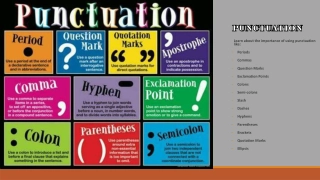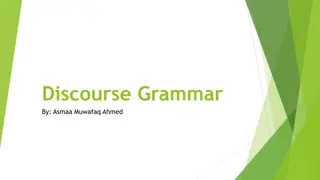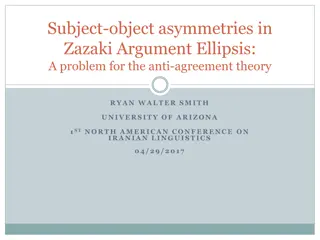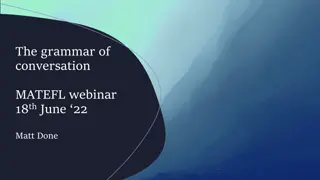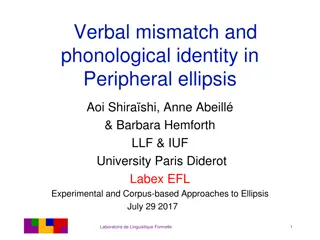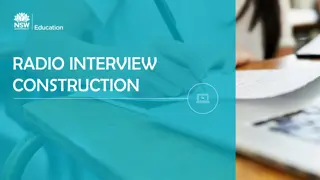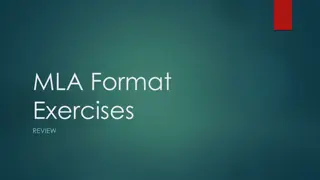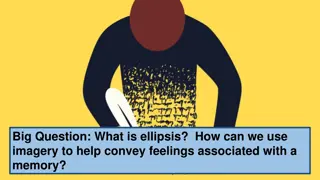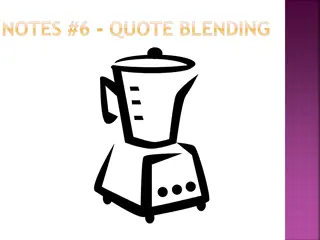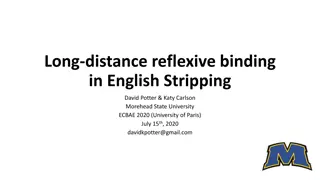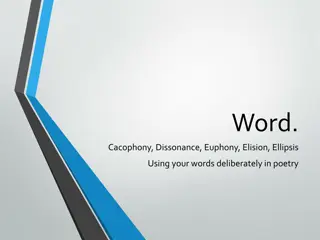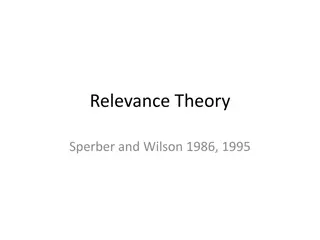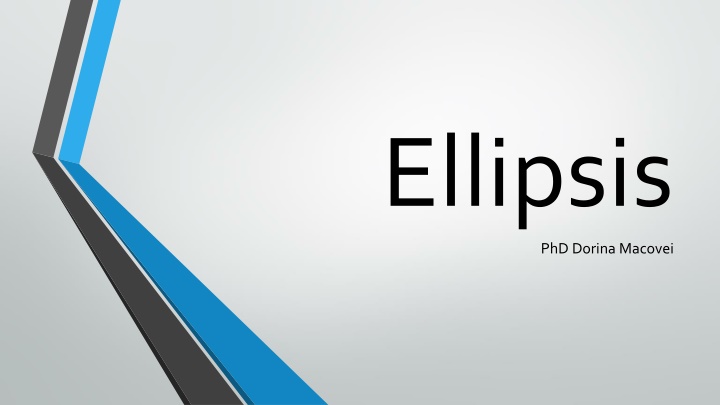
Ellipsis in Grammar: Examples and Practice
Explore the concept of ellipsis in grammar, particularly focusing on its usage after auxiliaries. Learn how ellipsis helps avoid repetition in sentences, with examples and exercises to improve your understanding. Discover when to use "do so" in place of a repeated verb phrase. Enhance your grammar skills with this comprehensive guide.
Uploaded on | 2 Views
Download Presentation

Please find below an Image/Link to download the presentation.
The content on the website is provided AS IS for your information and personal use only. It may not be sold, licensed, or shared on other websites without obtaining consent from the author. If you encounter any issues during the download, it is possible that the publisher has removed the file from their server.
You are allowed to download the files provided on this website for personal or commercial use, subject to the condition that they are used lawfully. All files are the property of their respective owners.
The content on the website is provided AS IS for your information and personal use only. It may not be sold, licensed, or shared on other websites without obtaining consent from the author.
E N D
Presentation Transcript
Ellipsis PhD Dorina Macovei
https://dictionary.cambridge.org/grammar/british- grammar/ellipsis UK /i l p.s s/ US /i l p.s s/
Ellipsis after auxiliaries avoidance of repetition We often use just the first part of a verb phrase, instead of repeating words which have already been said or written, or which can be understood from the context. They have promised to compensate the villagers, and we believe that they will [compensate the villagers] (more natural than .. . that they will compensate the villagers.) 'Is she happy?' 'I think she is [happy]`
Ellipsis after auxiliaries ellipsis first Normally words are dropped after they have been used once, but it can happen the other way round if a sentence starts with a conjunction. When you can [send us a postcard], please send us a postcard. If I may [explain something to you], Id like to explain something to you.
Ellipsis after auxiliaries Do in place of auxiliary When there is no auxiliary, DO is used in ellipsis. Does the dog eat cornflakes? He certainly does [eat cornflakes]. They wanted me to tell them the truth, so I did [tell them the truth]in the end.
Ellipsis after auxiliaries practice 'Have you got their address?' 'I'm sure I have got their address. If you can have a word with Phil, please have a word with Phil. 'The car's running badly` 'Yes, it is running badly.' Lucy doesn t go out much, and Sue doesn't go out much either.
Ellipsis after auxiliaries do so The slightly formal expression do so can replace a repeated verb phrase. The government has agreed to raise the retirement pension, and will do so as soon as the financial situation has improved. I need to speak to Anna. I'll try to do so tomorrow. He promised to paint the staircase, but he hasn't done so.
Ellipsis after auxiliaries We don t normally use do so if we are not talking about deliberate actions by the same person. I love the saxophone, and I always have, (Not... I always have done so: Not a deliberate (intentional) action.) Angela's taken her pilot's license, and I d like to do that too. (Not ...and I d like to do so: Not the same person.)
Finding sentencebeginnings. Try to write beginnings to go with the following endings:
Ellipsis with infinitives TO for whole infinitive We often use TO instead of repeating a whole infinitive phrase. 'We can't guarantee that we'll make a profit, but we expect to [make a profit].' Are you and GiIIian getting married?' 'We hope to [get married].' 'Let s go for a walk this afternoon.' 'I don't want to [go for a walk this afternoon]'' 'Sorry I shouted at you. I didn't mean to [shout at you]. Write 2 sentences of your own
Ellipsis with infinitives Be and have are not usually dropped after TO. There aren't so many butterflies as there used to be. (Not as there used to) I haven t got aII the papers that I expected to have. (Nor...I expected to) Write 2 sentences of your own
Ellipsis with infinitives dropping TO TO is used like this particularly after verbs that don t usually stand alone, but need to be followed by an infinitive (as in the above examples). In other cases, we may drop TO as well as the infinitive. 'Did you get the eggs?' 'Sorry, I forgot / I forgot to.' (Forget often stands alone) 'See if you can cheer Maggie up.' 'I'll try / I'll try to.' (Try often stands alone.) He'lI never leave home. He hasn't got the courage / the courage to. (after a noun) I'm not going to do the exam. I'm not ready / not ready to. (after an adjective)
Ellipsis with infinitives And note the common use of LIKE without TO after a conjunction. Use my car if you like. Pay when you like. Park where you like.
Prepare short dialogues using some of the following:
Ellipsis with so and not We can use so instead of repeating words in a that-clause. This happens after believe, hope, expect, imagine, suppose, guess, reckon, think, be afraid. Are you ready?' 'I think so. (= I think that I'm ready) 'Shall we go to the party?' 'I suppose so. Make up two sentences including two verbs from this list.
Ellipsis with so and not negative structures We can make these structures negative in two ways. 'Will it rain?' 'I don't expect so. or I expect not. 'We won't have enough money for a holiday. 'I don't suppose so. or 'I suppose not.'
Ellipsis with so and not Hope and be afraid are normally used with not. Think is more common with don t so. I may have to work this weekend. I hope not. (Not I don t hope so) Is the bank open?' 'I'm afraid not.' 'Have you got a cold? 'I don't think so.'(more natural than I think not.)
Ellipsis with so and not after say and tell We can use so after say and tell to avoid repeating information. We use this structure mostly to justify statements - to say why they should be believed. Compare: Julie s crazy.' 'Who says so?' 'Dr Cameron. 'You're crazy.' 'Who said that?' 'I did.'
Ellipsis with so and not so I hear etc We can use so at the beginning of a clause with say, see, hear, understand, tell, believe and a number of other verbs. A present tense is common. It s going to be a cold winter, or so the newspaper says.
Ellipsis with so and not We often use so and not after if. Granny may come. If so, we'll play poker. He may be upstairs. If not, try next door. We don't use so before a that-clause or after know. I suppose that we ll have to go. (Not I suppose so, that we ll have to go) 'It's getting late. I know. (Not I know so)
Ellipsisafterand, but, or We often leave out repeated words or phrases after and, but and or. a knife and [a] fork. She was poor but [she was] honest. You can come with us or [you can] stay at home.
Ellipsis after and, but, or leaving out the first of the two When two verbs, objects etc. are the same, it is not always the second that is left out. We may leave out the first for clarity or simplicity. Cats [catch mice] and dogs catch mice. I can [go] and will go.
Ellipsisafterand, but, or normal word order In informal speech and writing, ellipsis does not usually interrupt the normal word order of a clause. This may happen, however, in a more formal style. Peter planned, and Jane paid for the holiday. (Less formal: Peter planned the holiday and Jane paid for it.) Kevin likes dancing and Annie athletics. (Less formal: Kevin likes dancing and Annie likes athletics.)
Ellipsis after and, but, or Note: other conjunctions Ellipsis is not normally possible after other conjunctions. She didn't know where she was when she woke up. (NOT when woke up)
Ellipsis of the beginning of spoken sentences In informal speech (and very informal writing) we often drop unstressed beginnings of sentences. This happens mainly with articles, possessives, personal pronouns, auxiliary verbs and be, demonstratives and introductory there is.
Ellipsis of the beginning of spoken sentences Coffee machine's broken. (= 'Thecoffee machine ... ) Wife s not well. (='Mywife . . . ) Need a loan? Can't read this email? Click We only drop pronouns before stressed words. Need some help. Haven't heard. Can't play. BUT NOT Have heard or Can play (Affirmative auxiliaries are usually unstressed.)

